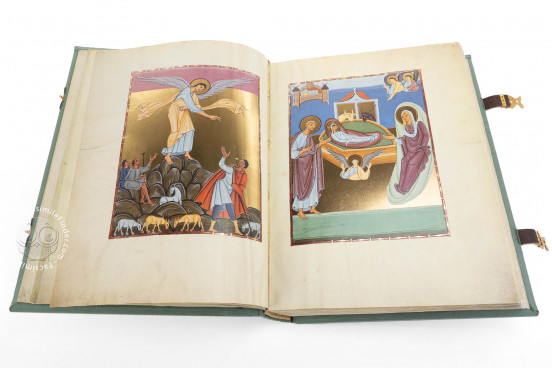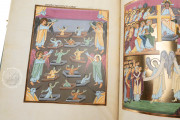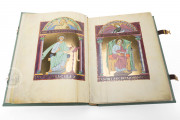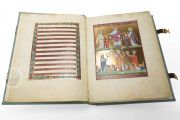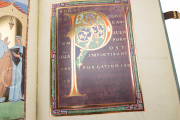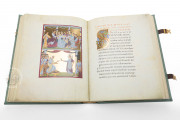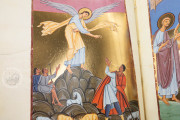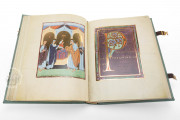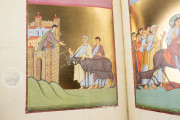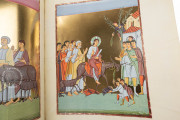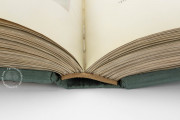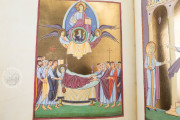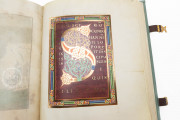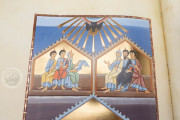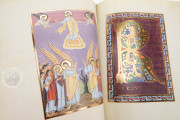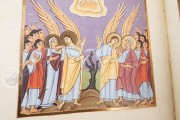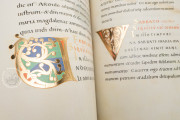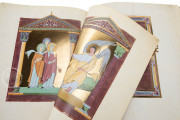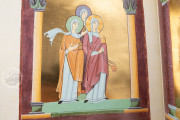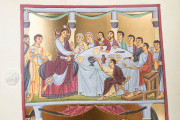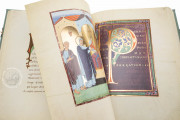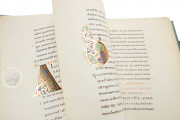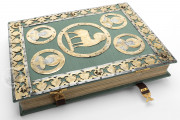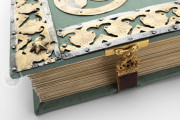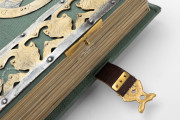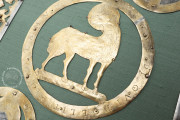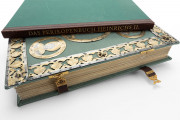The Pericopes of Henry II is one of the monumental highlights of Ottonian illumination. It is a manuscript of the Gospel readings for use in the Christian Mass in the order in which they are to be read during the liturgical year. It was probably created by the artistic personalities tied to the famed scriptorium of the monastery on the island of Reichenau in Lake Constance. The Holy Roman Emperor Henry II and his consort Cunegunde commissioned the manuscript as a gift for the consecration of the cathedral of the newly established diocese of Bamberg in 1012. It boasts twenty-eight masterful full-page miniatures in vivid colors and with burnished gold backgrounds.
The codex is one of several imperial offerings bestowed upon Bamberg when the cathedral was consecrated. The style of the miniatures is closely tied to the Gospel Book of Otto III, a manuscript Henry II also donated to Bamberg. The Pericopes are thus associated with the so-called Liuthar group of manuscripts illuminated at Reichenau.
Monumental Miniatures
Depictions of the four evangelists—the authors of the accounts of the life of Christ included in the Christian Bible—herald the readings (fols. 3v-4r and 5v-6r). The authors are shown seated under large arches occupied by their symbols (man, lion, calf, and eagle).
The evangelist portraits are followed by Christological scenes and images of saints illustrating the principal feasts of the liturgical calendar. Many of the paintings are arranged as double-page openings. This format allowed for the presentation of key events in Church history across large expanses of parchment.
The size of the gold background varies among the miniatures and is combined with flat strips of other colors to create an alluring division of the pictorial field. Although the miniature of the Ascension lacks gold in its background, the sharp division from the velvety purple to the pink sky emphasizes the risen Christ's transition into a heavenly realm (fol. 131v).
Exalting the Word
The manuscript also features ten full-page framed incipit pages. With grand golden frames featuring meander motifs, these pages celebrate the elaborate first letters of the Gospel passages on fields of imperial purple or alternating horizontal strips of purple and bare parchment.
Written entirely in gold and delicately ornamented with floral motifs, the incipit pages emphasize the sacred nature of the text. The celebration of writing extends to headings and incipits written in Uncial and Rustic Capitals. Two scribes were likely responsible for the professional Caroline Minuscule of the text.
Bamberg as the New Rome
The manuscript opens with a dedication poem paired with an image of the coronation of Henry II and Cunegunde (fols. 1v-2r). Written entirely in gold in fine Uncials on purple strips, the poem describes how the manuscript was a gift from the emperor at the consecration of the cathedral and asks for the intercession of Saints Peter and Paul, the patrons of the city.
In bestowing lavish gifts on the cathedral, the emperor fashioned Bamberg, the center of his realm, as a new Rome. Scholars have described Henry II's elaborate gifts as a "material self-portrait" that eventually laid the groundwork for his and Cunigunde’s eventual canonization.
The Pericopes of Henry II remained in the possession of Bamberg's cathedral until 1803, when the manuscript was moved to the Bayerische Staatsbibliothek. In 2003 the manuscript was inscribed on the UNESCO Memory of the World Register.
A Treasure Binding of Gold and Ivory
The book boasts a treasure binding. A ninth-century Carolingian ivory is set into the middle of a gold frame studded with precious stones and enamel busts of Christ and the apostles, along with medallions of the evangelist symbols. The back features five medallions and a decorative frame of silver and gilt silver work set on green silk. Roundels of the four cardinal virtues surround a central medallion inhabited by the Agnus Dei. It is unclear where the binding was made; it has been suggested that the older fragments were gathered in Regensburg and repurposed for this manuscript.
We have 1 facsimile edition of the manuscript "Pericopes of Henry II": Perikopenbuch Heinrichs II facsimile edition, published by Mueller & Schindler, 1994
Request Info / Price
